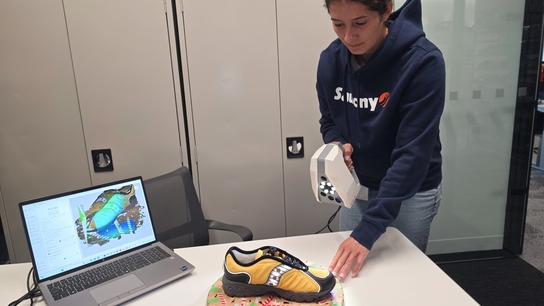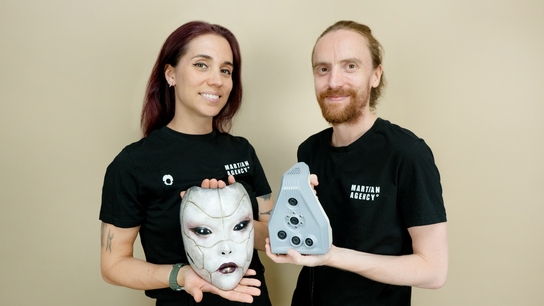Digitally preserving priceless Tasmanian seashells with Artec Micro
Challenge: As a member of the Pakana community of Lutruwita (Tasmania), in the face of the rising impacts of climate change and ocean acidification, Andrew Gall was determined to find a way to preserve the ancient and threatened seashell gathering tradition of his people. He settled on 3D scanning and 3D printing as his solutions of choice.
Solution: Artec Micro, Artec Studio, 3D printing (liquid ceramic)
Results: In collaboration with a local Artec 3D partner, the Artec Micro desktop scanner was employed to capture every detail of a range of irreplaceable Tasmanian seashells. Artec Studio generated lifelike 3D models with an impressive accuracy of up to 10 microns. The shells were then 3D printed as exact replicas using liquid ceramic. This innovative approach swiftly and safely preserved the artifacts, merging ancient tradition with 21st century technology.
Why Artec? To bring this project to life, Dr. Gall needed a 100% safe, non-contact, ultra-high-resolution 3D scanner that could capture fragile seashells in all their variegated glory: Artec Micro.

Hazards Beach, Freycinet National Park, Tasmania
Out at the far edge of the world, on the Australian island of Tasmania, an ancient cultural practice is being threatened by the unforgiving forces of climate change.
It is here that we find Andrew Gall, a Pakana artist and D.V.A. (doctor of visual arts), who has devoted his life to preserving the rich cultural heritage and ways of his people, the original inhabitants of the island.
As a member of the Pakana community of Lutruwita (Tasmania), Gall strives through his work to embody the sacred link between the land, the ocean, the people, and the seashells that have been central to the Pakana way of life for millennia.
For thousands of years, the Pakana women have been the keepers of this enduring practice, where they make their customary morning journey down to the beach, to begin the gathering.
There lie the seashells, shimmering with their iridescent colors, waiting to be painstakingly collected along the water’s edge, and later transformed into intricate shell necklaces by these women, who have learned this patient art from their mothers and grandmothers.

Thinglab’s Director of 3D Scanning Ben Myers finishing up an Artec Micro 3D scan of a Tasmanian seashell, in Artec Studio software. Image courtesy of Thinglab
A venerable tradition under threat
This is not just a tradition, but a vivid testament to the profound connection between the Pakana people and the living world around them.
But, as climate change accelerates and ocean acidification takes its toll, these precious shells are disappearing at an alarming rate, and with them, the very essence of an ancient culture.
Gall, who had worked in IT and technology for years, changed paths to honor his culture and its traditions, recognizing the urgency of the situation.
He understood that the fate of his people’s traditions rested on their unceasing ability to adapt, to embrace innovation, and to find new ways of preserving their cultural artifacts. And so began his quest to find the right technology to help protect the Pakana’s irreplaceable treasures.

Artec Micro scan of a Tasmanian seashell in Artec Studio software. Image courtesy of Thinglab
In search of the best solution
Like a detective, Gall pursued a series of false leads and disappointments, exploring rubber molds and wax casting, only to discover that these time-consuming processes were simply impractical. Undeterred, he shifted his attention to 3D scanning, and diligently reached out to every possible scanning specialist he could find.

Tasmanian seashell being scanned on Artec Micro’s circular scanning platform. Image courtesy of Thinglab
Time and time again, however, they either couldn’t guarantee the results he needed, or failed to address his concerns and questions properly. Finally, he connected with Ben Myers at Artec Gold-certified Specialists Thinglab, who took his work seriously from their very first meeting.
Gall quickly saw that Thinglab was the ideal partner for this demanding endeavor, as they not only had all the technical know-how, they also understood his vision and shared his passion for preserving the cultural heritage of his people.
Meeting the Artec Micro
It was there that Myers, a 3D scanning expert, introduced Gall to Artec Micro, a cutting-edge device capable of capturing all the colors and intricate details of these delicate seashells, with a breathtaking accuracy of up to 10 microns (about 1/5th the width of a human hair).
The Artec Micro, like a powerful microscope, allowed Gall and Myers to create exquisitely lifelike 3D models of the shells, capturing every minute detail of the originals, even the tiniest of holes.

Artec Micro scan of a Tasmanian seashell in Artec Studio software. Image courtesy of Thinglab
A firm believer in the use of technology to solve real-world problems, Myers said, “3D scanning is not simply an innovative solution for cultural preservation, but also a powerful tool for fostering empathy, understanding, and appreciation for the rich tapestry of human experiences that shape our world.”
With these digital blueprints in hand, Gall was then able to 3D print ultra-realistic replicas using liquid ceramic, ensuring the preservation of these invaluable artifacts, even if the shells themselves eventually get lost or destroyed.
Hope for the decades and centuries ahead
Gall’s story is one of resilience and adaptability, highlighting how 21st century technology can help preserve the wisdom and ways of the past. This is a stirring example of how 3D scanning and printing can help traditional societies deal with the devastating consequences of a rapidly changing world.
By harnessing the power of technology, we can not only protect our collective cultural inheritance, but also create new ways of engaging with and experiencing it.
Gall said, “With the help of the Artec Micro, we’ve brought to life a bridge between the ancient traditions of the Pakana people and the latest 3D technology of today, ensuring that this part of our cultural heritage remains vibrant and alive for generations to come.”

Close-up of a Tasmanian seashell being captured by Artec Micro’s blue structured-light. Image courtesy of Thinglab
Through virtual museums, AR/VR storytelling, and 3D-printed replicas for use in museums and schools, it’s now possible to ensure that the traditions and ways of those who came before us remain accessible and relevant to future generations.
As the world continues to confront the challenges of climate change, we can look to Andrew Gall and the Pakana people as beacons of hope, demonstrating the transformative power of creativity and innovation in the face of dire adversity.
How technology can bring us together
It is through such pioneering efforts as this that we can safeguard the ancestral cultural treasures of humanity, allowing them to continue to inspire, enlighten, and captivate us.

Liquid porcelain 3D-printed Tasmanian seashells fresh from the printer. Image courtesy of Andrew Gall
The world is a veritable cornucopia of small, exquisite cultural artifacts that tell the myriad stories of native peoples and their rich histories. As time and the elements threaten to erode these fragile and precious heirlooms, 3D scanning steps into the spotlight, offering a means to preserve and safeguard their delicate beauty.
Using the power of this revolutionary technology, the elaborate designs of African tribal masks, the intricate beadwork of Native American tribes, and the detailed craftsmanship of Inuit ivory carvings can all be captured in astonishing detail, breathing new life into these cherished relics and enabling them to live on.

3D-printed porcelain Tasmanian seashell bracelets and necklaces, strung by Andrew Gall’s daughter and two granddaughters. Image courtesy of Andrew Gall
In the words of Gall, “3D scanning has the potential to become a unifying force for native peoples worldwide, empowering us to preserve our most cherished artifacts and share them with other communities and schools across the globe.”
He continued, “This technology transcends borders, enabling us to celebrate our unique cultural identities while cultivating understanding, respect, and collaboration among the thousands of surviving indigenous communities.”
Scanners behind the story
Try out the world's leading handheld 3D scanners.





